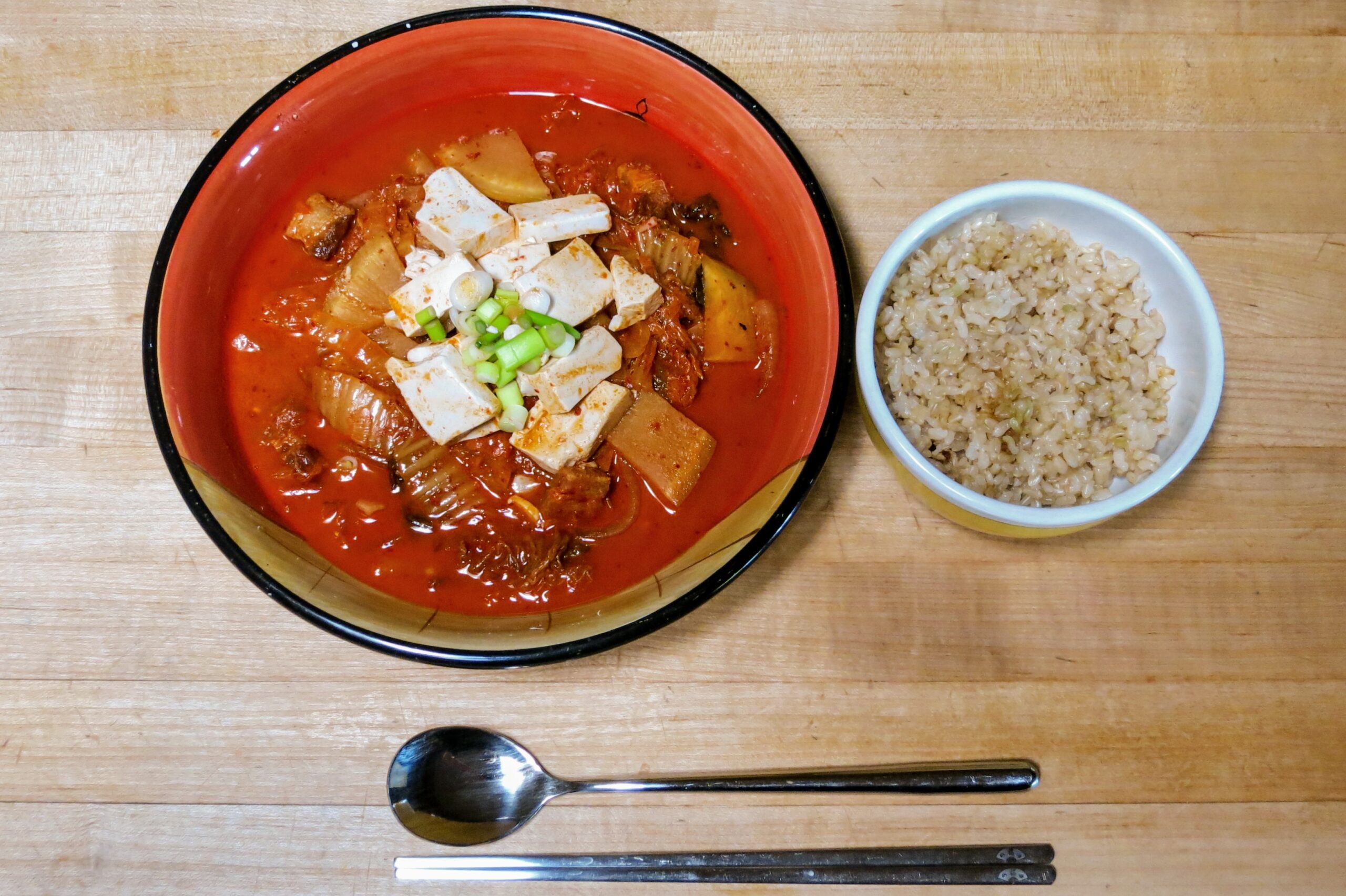Kimchi stew is one of the foods I miss most from my time in Korea. It’s full of Korean pickled cabbage and topped with crispy pork belly. Spicy and satisfying, it’s a perfect stew for long, cold winter nights.
Jump to RecipeI miss Korea
My two years in Korea were a lot of fun. I met a ton of friends from all over the world and I miss them dearly.
It’s one of the weird things about being a traveler. Your life embodies that Georges Simenon quote: I am at home everywhere, and nowhere. I am never a stranger and I never quite belong. Every traveler I know has felt this way at least once.
That’s one reason why food matters so much to me. It’s a representation of an entire culture or set of experiences and you can share it with others.
But more importantly, it’s a source of community in a disconnected world. When you break bread with others, it creates a sense of love and community.
This is why I never diet when I travel and I eat everything I can. When I share Korean food with my new friends, it’s like I’m sharing a part of my old life with them.
Korean Food
And damn do I miss Korean food. It is delicious, hearty, and simple. It’s the perfect food for cold, dark winter months. It warms you up and keeps you happy. And most Korean food takes less than 45 minutes to put together.
For me, Korean food is all about two things: pickles and stews.
Kimchi, the Korean word for “pickle,” is a must. Kimchi is served with every meal and is a delicious staple. Ever since coming back from Korea, I’ve missed good kimchi.
Koreans also love soup. They tend to serve some sort of soup or stew with almost every meal. The stews, like kimchi jjigae or yukgaejang, tend to be hearty and take center stage. The soups are usually light and brothy and work as a satisfying side dish. But they’re always there.
To me, Kimchi stew is one of the most quintessential Korean foods.
Making Kimchi Stew
Kimchi stew takes about 30-45 minutes, start to finish. Honestly, the hardest part is finding some of the ingredients. Unless you have an international market nearby, you might struggle. You can hunt them down if you want, or just skip them as needed.
Pork belly, tofu, chile, onion, daikon radish, green onion, and garlic. And of course, a mound of cabbage kimchi.
Frying the Pork Belly
This step isn’t necessary and most Koreans I know don’t do it. If you’re short on time, you can skip it. But I think it greatly improves the final stew.
Start by taking the pork belly and adding it to a large pot. Sprinkle a bit of salt on top and fry it on medium for about 10 minutes. Check on the pork every minute or two and stir regularly.
You can use high-quality, thick-cut bacon if you can’t find pork belly. If you do that, don’t add any extra salt.
You’re trying to render as much fat as possible out of the meat. This does two things. It gives you a bunch of fat to use as a frying liquid. It also creates really crispy pork. I personally love crispy bacon. If you don’t, then consider skipping this step.
If you want to make a vegetarian kimchi stew just add 2 tablespoons of oil to the pot and proceed from here.
Putting the Kimchi in Kimchi Stew
Once you’ve rendered the fat out of the pork, remove the pork from the pot. You can leave it in there, but it will no longer be crispy when you’re done. I like crispy pork, so I take the extra minute to remove it. If you don’t, then leave it in the pot.
Now it’s time to add most of the rest of the ingredients.
Typically, adding watery liquid to hot fat is not a great idea. It spits. A lot. In the past, I have ended up with butter all over the walls and floor of my kitchen. It was a nightmare to clean.
Now, I take some precautions to avoid this. Whenever I add liquids to hot fat, I take the pot off the heat, quickly add the liquid, and slam a lid on top until the spitting dies down.
So take the pot off the heat, add the kimchi and put a lid on it.
Once the spitting has quieted, remove the lid and add the rest of the kimchi stew ingredients to the pot, except for the tofu, the green onions, and the rice. If you add the tofu now, it will overcook. The rice and the sliced green onions are for serving.
Bring everything to a boil and then reduce it to a simmer. Let it simmer for 10 minutes or so.
Add the Tofu
After you’ve let everything simmer for a bit, lay the sliced tofu across the top of the simmering kimchi stew. Just leave it there. If you mix it in, it’ll turn mushy and weird.
Continue to let the kimchi stew cook for another 10 minutes.
Now it’s done. Put it into a bowl. Sprinkle the pork and the sliced green onions on top.
Serving Kimchi Stew
You have a few options when serving kimchi stew.
Rice is the standard side dish. Koreans eat a bowl of short grain rice with almost every meal. It’s a great pairing.
If you don’t want the rice, you could just eat the stew plain. Kimchi stew is tasty and satisfying on its own. It’s loaded with good fats and awesome vegetables. This is usually what I do if I’m eating leftovers for lunch.
I also recommend topping it with an egg. Eggs are great. They’re nutritious, full of choline and other important nutrients. They’re also a healthy source of cholesterol.
If I’m feeling fancy, I’ll go through the trouble of soft-boiling an egg and serving it on top, like a bowl of high-end ramen. If not, I’ll just quickly fry one and throw it on top.
Below, I served a batch of vegetarian kimchi with steak, eggs, and avocado.
No matter what you do, it’s really hard to screw up kimchi stew. It’s delicious and hearty.
Korea knows stew.
Kimchi Stew – 김치찌개 (Kimchi Jjigae)
Ingredients
- 1/2 pound pork belly sliced *
- 1 teaspoon kosher salt
- 1 cup daikon radish sliced
- 1/2 medium onion sliced
- 2 green onions chopped
- 6 cloves garlic minced
- 1/4 cup kimchi juice
- 1 Tablespoon Korean pepper flakes **
- 1 Tablespoon gochujang paste (optional) **
- 1 Tablespoon Doenjang paste **
- 1 teaspoon kosher salt
- 1 teaspoon sugar (optional) **
- 1/2 teaspoon black pepper
- 1 pound kimchi chopped, 2-3 cups
- 2 cups water or broth
- 1 pack extra firm silken tofu thickly sliced
- 1 green onion sliced finely, for serving
- 2 cups cooked rice (optional) preferably short-grain, for serving
Instructions
- (Optional step for crispy pork) Place a pot on medium heat. Add pork and cook until crispy. Stir or flip every couple minutes. It should take 5-10 minutes to get the pork crispy. Remove the pieces of pork and set them on a plate. Leave the fat in the pot.
- Remove the pot from the heat. Add the kimchi and quickly put on a lid. Once the spitting dies down, add everything else except the tofu, sliced green onion, and the rice. Stir to mix.
- Return the pot to medium heat. Bring the stew to a boil and then reduce to a simmer. Cook at a simmer for 10 minutes.
- Lay sliced tofu across the top. Do not stir it in. Cook for 10 more minutes.
- Serve the stew in a bowl. Top with the pork and the sliced green onions. Serve with a side of rice if desired.









